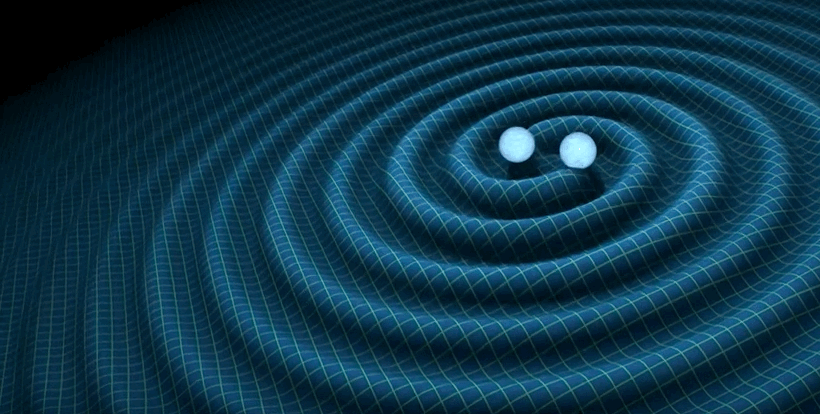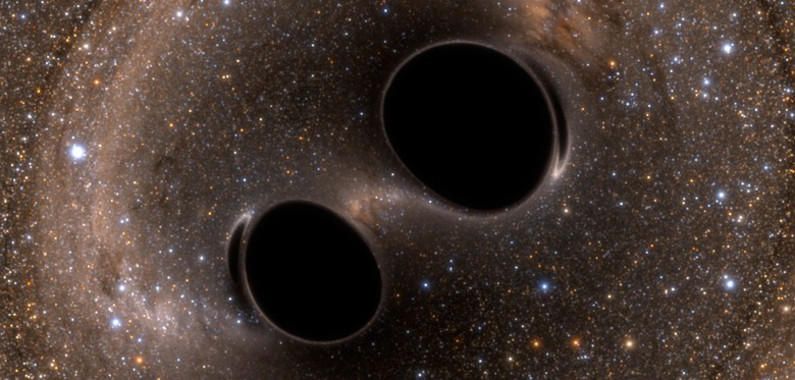Gravitational waves are concentric ripples shrink and stretch the ‘fabric’ of space-time. / NASA
In February this year the Observatory for Interferometry Laser Gravitational Wave (LIGO) in the United States, announced that it had managed to detect for the first time gravitational waves, distortions spacetime predicted by Einstein. The signal, called GW150914, was registered on September 14, 2015 in the two detectors twins have this observatory in Livingston (Louisiana) and Hanford (Washington). Its origin was in the merger of two distant black holes, scientists say.
Now, members of LIGO report that last year also made another observation of gravitational waves produced by the collision and binding of another pair of black holes (with 14 and 8 times the mass of the Sun), which ended up forming one of about 21 solar masses. During melting, an amount roughly equivalent to the mass of our star power became gravitational waves.
The new signal, called GW151226, came to the detectors on December 26, 2015 and he measured in 1.1 milliseconds before Livingston detector in Hanford. This gives a rough idea of the position of the source in the sky, which experts put at 1,400 million light years away.

“it is very significant that these black holes were much less massive than the first detection (whose masses were 36 and 29 times the Sun),” said Gabriela Gonzalez, spokeswoman for scientific collaboration LIGO and professor of physics and astronomy at the Louisiana State University (USA).
“Because of its lighter mass -around spent more time in a second- sensitive detectors band,” adds the researcher, who It emphasizes. “it’s a promising start for the study of populations of black holes in our universe”
the discoverers also stress that GW151226 is the second confirmed a merger of black holes observation and, together with GW150914, “marks the beginning of gravitational wave astronomy as a revolutionary new way to explore new frontiers of our universe, especially its darkest and most energetic events”.
“with the detection of two strong events in the four months of our first observation period, can begin to make predictions about the frequency with which they could be listening gravitational waves in the future, “said Albert Lazzarini, deputy director of LIGO from the Caltech institute.
gravitational waves produced by objects such as black holes pair of stretch and compress the space-time as they propagate through the universe. This effect of stretching and compression, highly attenuated and when he came to Earth, is the one who recorded the advanced and sensitive detectors, called Advanced-LIGO to be an improved version of the first generation version.

illustration of a merger of two black holes, gravitational waves generated as the detected now. / LIGO
Spanish Participation in the new discovery
The GW151226 signal was identified just 70 seconds of his arrival to Earth with mathematical algorithms. About a minute later, the first indications of its origin had thanks to a technique known as adaptive filtering, where the data are compared with predictions of gravitational signals to find the one that best matches.
In this case, matched filtering was essential for both detection and for subsequent analysis of GW151226, because of lower intensity compared to GW150914 and because it is difficult to see with the naked eye.
the development of accurate catalogs forms based on the general, essential relativity to study mergers of black holes, wave is one of the main activities of the Group of relativity and Gravitation (GRG), led by researcher Alicia Sintes from the University of the Balearic Islands, study participant .
in addition, the formulas of this equipment are used to generate the hundreds of thousands of wave patterns used in analysis of LIGO data. To calibrate these patterns numerical simulations generated with the help of European computational infrastructure (PRACE) and the Spanish Supercomputing Network used
Calculations in Barcelona
. Professor Sascha Husa member of the IBC, has had access to MareNostrum, the most powerful supercomputer in Spain Barcelona Supercomputing Center – National Supercomputing Center (BSC-CNS), which has been essential for the development of these catalogs. Both Sascha Husa and synths are part of the Council of LIGO and participated, along with other members of the UIB, in the articles of these findings.
The LIGO observatories are funded by the National Science Foundation ( NSF) in the USA. They were designed, constructed and are currently operated by Caltech and MIT institutes. The new findings, accepted for publication in the journal Physical Review Letters, was conducted throughout the LIGO Scientific Collaboration (including the British-German collaboration GEO and the Australian Consortium for Interferometric Gravitational Astronomy), together with the collaboration Virgo, another detector gravitational waves located in Pisa (Italy).
research is carried out by more than 1,000 scientists from the US and 14 other countries. In addition, more than 90 universities and research centers develop technology for the detector and analyze the data. The next observation period with Advanced-LIGO will take place this fall, when they have introduced further improvements in the sensitivity of the detectors to reach a volume of universe to twice as large as the current one.
Original article here .
No comments:
Post a Comment